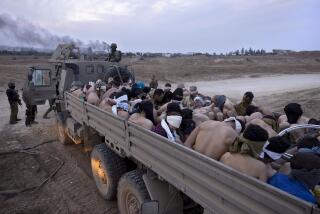Floating Hospital Readies Itself for Possible Conflict
- Share via
WASHINGTON — Hospital Corpsman 3rd Class Christopher Mauk stood next to the Christmas tree still bright with holiday cheer Thursday in the rotunda of the National Naval Medical Center, the Art Deco hospital commissioned by President Franklin D. Roosevelt.
He looked tearfully at his wife, Heather, and the double stroller she was rocking, sleeping headquarters for their 3-month-old twins, Kyle and Cole, oblivious to the camera crews crowding in for a shot. “I don’t like the fact that they may not know who their father is when I get home, but they’re in good hands,” he said.
Mauk is among the 300 medical personnel and 61 crew members preparing to deploy as soon as next week on the Comfort, one of two 1,000-bed hospital ships maintained by the Navy to provide on-site care for U.S. forces in war zones. When another 1,000 or so medical staffers fly in to join them, the floating hospital will be fully staffed, one more sign that President Bush is readying U.S. forces for a possible war in Iraq.
“The only thing I’ve been told is to get the ship ready for possible deployment next week,” said Capt. Charles Blankenship, who was the vessel’s top surgeon during the Persian Gulf War in 1991. Asked if such preparations signaled war, he replied: “Our primary mission is combat support.”
Mindful that the Comfort’s mission could be stressful for families left behind, the center Thursday hosted more than 100 relatives -- including some babies and at least one toddler bearing a Winnie the Pooh teddy bear -- to offer guidance and services.
There were pep talks from officials such as Deputy Cmdr. Michael Krentz. “Thank you for disrupting your lives to keep us all safe,” he said.
There were tips on handling stress from Cmdr. James Reeves, a psychiatrist. Among them: Keep your sense of humor, and don’t put your life on hold.
And there were questions about salaries being deposited correctly and reminders to draw up wills and concerns about side effects from anthrax and smallpox vaccines.
Mostly, there was a sense of mission.
“My job is to fix them up,” Mauk said of his prospective work with patients. “I’m going to do my job, whatever the president tells me to do.”
The Comfort has been called to war before, and docked at Pier 92 in Midtown Manhattan on Sept. 14, 2001, to aid in the rescue mission after the terrorist attacks on the World Trade Center. When few survivors were found, the ship became an aid station for relief workers.
The floating hospital treated 561 people for cuts, respiratory ailments and fractures, provided workspace to New York area massage therapists who donated 1,349 therapeutic massages, and even nursed the raw paws of rescue dogs.
But a war with Iraq would pose special dangers. Many political observers fear that Iraqi President Saddam Hussein, fighting for his hold on power, would unleash weapons of mass destruction.
And military experts worry about a heavy casualty toll from urban combat and the prospect of house-to-house fighting on the streets of Baghdad. CIA analysts have estimated that the toll could go as high as 5,000 American troops.
But hospital officials said they were confident that they have the crew, and the equipment, to meet the direst predictions.
“We always train for the worst-case scenario,” Blankenship said.
The vessel and its crew have been trained and equipped to handle chemical and biological contamination. The first rooms off the flight deck are for troops who may have been contaminated, allowing them to be cleansed of chemicals before they join the rest of the ship.
There are 12 operating rooms, a lab, a pharmacy and two oxygen-producing facilities. There are new state-of-the-art medical machines -- technicians just installed equipment to perform angiograms -- the radiology unit is fully digitized and, as spokesman Lt. Cmdr. Edward Austin put it, “We can do tele-medicine and get a consult.”
The Navy has also made efforts to improve communications between the crew and families at home. E-mail and postal mail are both encouraged, and the Navy suggests writing home at least once a week.
Lt. Cmdr. Dave McMindes, a nurse anesthetist who spent a few months last summer on the Comfort during a training mission in the Baltics, has one more suggestion: Bring a good book. He and his wife, Lizette, parents of two boys, ages 15 and 19, are both from military families, accustomed to the routine of duty.
With rumors of war in the air, McMindes said he was not surprised by the orders to deploy. “It’s been sunk in for a while,” he said. And the family was grateful that the deployment came after the Christmas and New Year’s celebrations.
“At least,” said Lizette McMindes, “he was home for the holidays.”
*
(BEGIN TEXT OF INFOBOX)
Medical care on the sea
The Comfort is one of two hospital ships the Navy provides for on-site care for U.S. combat forces in war zones. A look at the vessel and its amenities:
Comfort facts
Length: 894 feet
Width: 105.7 feet
Displacement: 69,360 tons
Speed: 16.5 knots
*
Services:
Casualty reception
Radiological services
Main laboratory plus satellite lab
Central sterile receiving
Medical supply/pharmacy
Physical therapy and burn care
Dental services
Optometry/lens lab
Morgue
Laundry
Two oxygen producing plants
*
Patient care wards
Intensive care wards: 80 beds
Recovery wards: 20 beds
Intermediate care wards: 280 beds
Light care wards: 120
Limited care wards: 500 beds
Total patient capacity: 1,000
Operating rooms: 12 beds
*
Source: U.S. Navy
More to Read
Sign up for Essential California
The most important California stories and recommendations in your inbox every morning.
You may occasionally receive promotional content from the Los Angeles Times.













